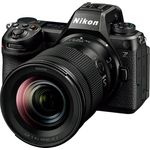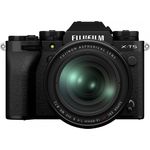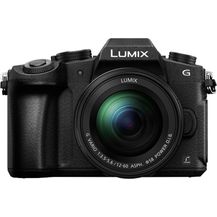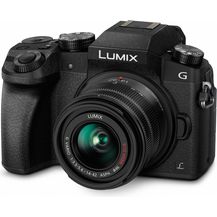Panasonic Lumix DMC-GF2
Produktdetails
- Autofokus: ja
- Bildstabilisator: nein
- Suchertyp: LCD-Monitor
- Ausstattung: Integrierter Blitz
- Outdoor-Gehäuseeigenschaften: nein
Fachmagazine

Die ältere, flache Micro-Four Thirds-GF-Kamera von Panasonic bringt noch einen Blitzschuh mit, die Bildqualität hinkt etwas hinter den neuen Modellen her.

Getestet mit Lumix G Vario 14-42 mm.
Systemzwerg. Gute Sytemkamera ohne Spiegel. Nur sieben Zentimeter hoch und gut im Bild. Schwachpunkt: Kein Sucher. Der Monitor ist gut, bei Sonnenlicht noch passabel. Aufstecksucher ab ca. 170 Euro. KEine Dauerbelichtung. Innovatives Konzept: Bedienung über Bildschirm (Touchscreen).

The Panasonic Lumix GF2 offers DSLR quality and controls in a significantly smaller package.

Bildqualität (50%): 76%; Geschwindigkeit (20%): 71%; Ausstattung (20%): 71%; Bedienung (10%): 85%
Die GF2 lässt sich im Gegensatz zur GF1 per Touchscreen bedienen. Die Ausstattung ist eher bescheidener geworden (z.B. keine Blitzbelichtungskorrektur, kein Fernauslöseranschluss).

Handliche Systemkamera ohne Sucher.

More than any device in recent memory, the Panasonic Lumix DMC-GF2 is a showpiece for the benefits and drawbacks of a touchscreen interface. Although the camera's touchscreen UI introduces a few groundbreaking features to the compact interchangeable-lens camera category, it may leave you longing for old-fashioned analog controls more often than not.
The Lumix GF2 is an enticingly compact interchangeable-lens camera, but its touchscreen interface is an inefficient way to access some important controls.

So gut die Ausstattung der neuen GF2 ist, in puncto Bildqualität schneidet die sehr ähnliche Olympus bei niedrigen ISO-Stufen besser ab, da die Panasonic stärker rauscht und etwas geringer auflöst. Bei ISO 800 dreht sich das Ergebnis und die Panasonic zieht mit ihrer besseren Feinzeichnung an der Olympus vorbei. (...)
Gesamtpunktzahl: 39 Punkte

Die Kamera Panasonic Lumix DMC-GF2 ist eine kompakte DSLR Systemkamera ohne Spiegel mit kleinen Abmessungen, die für eine Kompaktkamera überzeugen. Die Panasonic Lumix DMC-GF2 besitzt eine Auflösung von effektiven 12,1 Megapixeln durch den eingebauten CMOS Sensor. Sie liegt gut in der Hand und lässt sich einfach bedienen. ...
Die Panasonic Lumix DMC-GF2 ist kompakt und überzeugt mit schnellen Reaktionen und einem durchdachten Touchscreen-Interface. Im RAW-Modus liefert die EVIL-Kamera zwar hervorragende Ergebnisse, doch die kamerainterne JPEG-Bildverarbeitung enttäuscht. Wer vornehmlich JPEGs schießt und hohe Ansprüche an die Bildqualität stellt, sollte sich nach einem anderen Modell umsehen. ...

Bildqualität: 54,6 von max. 60 Pkt., Visueller Eindruck 8,5 von max. 10 Pkt., Autofokus: 9.6 von max. 10 Pkt., Bedienung: 8,9 von max. 10 Pkt., Ausstattung: 9,4 von max. 10 Pkt.
Die Lumix GF2 landet knapp hinter der Olypmus E-PL2 und ist die zweitbeste MFT-Kamera ohne Sucher. Sie liefert trotz Detailschwächen insgesamt eine sehr gute Leistung im Test.

Though we still really like Panasonic's GF series, there are several trade-offs to take into account before you buy the Panasonic Lumix DMC-GF2. Its raw-format images look extremely good, but JPEG shooters looking for best-possible photo quality may get frustrated by image artifacts. And while lots of photographers will appreciate its relatively compact but functional design and zippy performance--though still not for action shooting--there's nothing special about its feature set, including underpowered video capture.

Die GF2 ist 3 mm schmaler als die GF1. Sie hat einen seperaten videoauslöser und eine Direktzugriffstaste für die "intelligente" Automatik. Touchscreen statt Moduswahlrad: Anders als die Vorgängerin Lumix GF1 hat die GF2 einen Touchscreen, der unter anderem das Moduswahlrad ersetzt.

Die Panasonic Lumix DMC-GF2 konnte gegenüber der DMC-GF1 in fast allen Punkten zulegen: Das Gehäuse ist kompakter, die Bildqualität vor allem bei höheren ISO-Zahlen besser, der Autofokus schneller, das Bedienkonzept dank Touchscreen flexibler, die Videoauflösung mit 1920 x 1080 Pixeln höher. Unterm Strich schneiden Olympus und Panasonic in diesem Test ähnlich gut ab, mit Vorteilen für Olympus bei der Bildqualität. Im Videomodus fehlt ihr zwar die Full-HD-Auflösung, dafür funktioniert mit ihrem Kit-Objektiv der kontinuierliche Autofokus zuverlässiger als bei der GF2. ...

Die Lumix ist immer noch schneller als die Pen und hat den besseren Videomodus. Die Bildqualität im Fotomodus ist nicht ganz so gut wie bei Olympus.

Bildqualität (45%); 68 Ausstattung / Handling (40%); 67 Geschwindigkeit (15%); 58 Gesamtwertung; 66,2

Panasonic's second compact interchangeable lens camera won't disappoint new users with its sleek footprint and very good image quality.
Panasonic's second compact interchangeable lens camera won't disappoint new users with its sleek footprint and very good image quality. It's those looking to upgrade who might be left feeling a tad disappointed, particularly compared to the strong offerings from other manufacturers in the same space. ...

The Panasonic LUMIX DMC-GF2 is one of the smallest Micro Four Thirds interchangeable lens cameras you will find on the Australian market. It has a 12-megapixel sensor that can capture stunning shots, it feels good to use, and you don't need a huge bag to carry it around in.
The Panasonic LUMIX DMC-GF2 is a great camera for any type of user. It's well built, easy to use and it can take sharp and vibrant images. It's one of a growing number of cameras on the Australian market with a touchscreen. You can only not only use it to navigate menus, but also to quickly set focus points and even to take photos without pressing the shutter button.

Testergebnis: gut (1,94); Preisurteil: günstig
Die Lumix DMC-GF2 rundet die Lumix-G-Reihe perfekt ab. Für 649 Euro bekommen anspruchsvolle Hobbyfotografen eine kompakte und leichte Systemkamera mit super Ausstattung, die eine gute Bildqualität liefert. ...

Staying ahead of the curve needs new technology and innovation - something the new Panasonic Lumix GF2 looks to herald by offering touchscreen technology as well as being the world's smallest and lightest interchangeable lens camera to come complete with a built-in flash.
The Panasonic Lumix GF2 seems to have a lot of future-thinking in place. There's touchscreen, 3D compatibility and Micro Four Thirds boasts the largest selection of lenses compared to any other Compact System Camera manufacturer. The new slimmed-down body size is great, though not without its issues: why the physical mode dial has been removed is beyond us (please bring it back) and the 14mm prime lens really isn't going to be for everyone (a body only option would have been great)...

A minor evolution of the already-excellent DMC-GF1, the Panasonic Lumix DMC-GF2 doesn't feel like a revelation and isn't worth the expense for existing GF1 owners. But with great DSLR-level image quality, interchangeable lenses and compact dimensions on the score card, GF-series newbies can't go far wrong here. Though the aim here with the GF2 was to fashion a compact system camera that was both easier to use and swifter than its predecessor, that aim has only been partly realised. ...
While the Panasonic Lumix DMC-GF2 is a worthy successor to the existing and soon to be phased out GF1, it's not the most direct, like-for-like replacement. This means that existing owners may well want to hang on to the camera they've already got - especially if they value the tactile nature of a chunky physical shooting mode dial over a virtual screen-based equivalent. While it is being touted as a direct replacement, we feel the two cameras could have happily existed in tandem for a while. ...

Last year, Panasonic launched the Lumix DMC-GF1 Micro Four Thirds camera to much success. The compact form factor and slew of advanced imaging features won not just the hearts of users upgrading from point-and-shoots, but professional photographers as well. This year, the Japanese electronics giant announced the GF2.
The GF2 will appeal to touchscreen point-and-shoot users who want to upgrade, but there are some minor issues that will irk advanced users.

The world’s smallest compact system (or “hybrid”) camera with a built-in flash also boasts a touchscreen capability too. But does all this techno wizardry push good old standard ergonomics a bit too far out the window? Pocket-lint’s Panasonic Lumix GF2 review has the lowdown. ...
Great touchscreen and small size get the thumbs up, but lack of main mode dial and no choice bar the 14mm F/2.8 lens may put off some prospective buyers. For those seeking a pocket-friendly hybrid camera, however, this is top quality and up there with as good as they come

Die GF2 ist noch kompakter als die Vorgängerin GF1 und hat ein anderes Bedienkonzept mit Touchscreen. Wegen des Vorserienstatus´haben wir noch keinen Labortest durchgeführt.".

The GF2 will be available in black, red or silver in the UK. Panasonic says it's about 19 per cent smaller than its predecessor and 7 per cent lighter. It retains most of the GF1's blocky, almost retro, styling. The GF2 is made mainly of metal, so it feels pleasingly solid.
The touchscreen Panasonic Lumix DMC-GF2 subtly refines its predecessor, the GF1. It's well worth a look if you're after a compact camera with swappable lenses.

Panasonic has finally announced the latest version of its Micro compact mirrorless cameras the Lumix DMC-GF2 – which is a smaller and lighter version of its GF1...

Als neuestes Mitglied der Lumix G Familie präsentiert sich die Lumix GF2 im deutlich verkleinerten Gehäuse und ermöglicht die Bedienung via Touchscreen. Ihr 12-Megapixel-Live-MOS-Sensor soll zusammen mit dem Venus Engine FHD nicht nur eine sichtbar bessere Fotoqualität ermöglichen, auch Videos können nun in Full-HD-Auflösung 1.920 x 1.080i und mit Stereoton im AVCHD-Format aufgenommen werden. ...
Mit ähnlichen Produkten vergleichen
| Kundenbewertungen | |||||||||||||||||||||
|---|---|---|---|---|---|---|---|---|---|---|---|---|---|---|---|---|---|---|---|---|---|
| Effektive Pixel | 12,1 MP | 45 Megapixel | 33 MP | 45,7 Megapixel | 24,2 MP | 50,1 Megapixel | 26 Megapixel | 45 MP | 61 MP | 24,2 MP | 32,5 MP | 24,5 Megapixel | 24,5 Megapixel | 40,2 Megapixel | 24,2 MP | 26,1 MP | 40,2 MP | 33 Megapixel | 24,24 MP | 24,5 MP | 26,1 Megapixel |
| Videoauflösung | - | Full HD, 4K, 2K, 8K | 4K/60 fps | 1.920 x 1.080p (120fps), 7.680 x 4.320p (30fps), 3.840 x 2.160p (120fps), 8.256 x 4.644 (60fps) | 4K (3840 x 2160 Pixel) | 1.920 x 1.080p (24fps), 3.840 x 2.160p (60fps), 3.840 x 2.160p (120fps), 7.680 x 4.320p (24fps), 7.680 x 4.320p (25fps), 7.680 x 4.320p (30fps), 1.920 x 1.080p (100fps), 3.840 x 2.160p (50fps), 1.920 x 1.080p (120fps), 1.920 x 1.080p (25fps), 3.840 x 2.160p (24fps), 3.840 x 2.160p (25fps), 3.840 x 2.160p (30fps), 1.920 x 1.080p (50fps), 1.920 x 1.080p (60fps), 1.920 x 1.080p (30fps), 3.840 x 2.160p (100fps) | 4K | 8K DCI RAW, 4K DCI, 4K UHD | 8K/24 fps | 4K (3840 x 2160 Pixel) | 4K (4096 x 2160 Pixel), 30 fps | 1.920 x 1.080p (25fps), 6.048 x 3.402 (60fps), 6.048 x 3.402 (50fps), 6.048 x 3.402 (30fps), 6.048 x 3.402 (25fps), 6.048 x 3.402 (24fps), 1.920 x 1.080p (30fps), 1.920 x 1.080p (60fps), 1.920 x 1.080p (50fps), 3.840 x 2.160p (30fps), 3.840 x 2.160p (25fps), 3.840 x 2.160p (24fps), 1.920 x 1.080p (120fps), 1.920 x 1.080p (100fps) | 1.920 x 1.080p (25fps), 6.048 x 3.402 (60fps), 6.048 x 3.402 (50fps), 6.048 x 3.402 (30fps), 6.048 x 3.402 (25fps), 6.048 x 3.402 (24fps), 1.920 x 1.080p (30fps), 1.920 x 1.080p (60fps), 1.920 x 1.080p (50fps), 3.840 x 2.160p (30fps), 3.840 x 2.160p (25fps), 3.840 x 2.160p (24fps), 1.920 x 1.080p (120fps), 1.920 x 1.080p (100fps) | 8K/30p Apple ProRes | UHD (3840 x 2160 Pixel) | 4K (4096 x 2160 Pixel), 30 fps | 4K (bis zu 60p) und 6.2K (bis zu 30p) | Full HD, 4K | 4K (3840 x 2160 Pixel) | 4K/UHD (3840 x 2160 Pixel), Full HD (1920 x 1080 Pixel) | Full HD, HD, 4K, 6,2K |
| Bildstabilisator | nein | Sensor-Shift | 5-Achsen-Bildstabilisierungsystem (IBIS) | Integrierter Bildstabilisator für ruhige Aufnahmen. | ja, optisch | 5-Achsen-Bildstabilisierung | 5-Achsen-Bildstabilisierung, gyroskopischer Bildstabilisator | optisch | 5-Achsen-Bildstabilisierung | nein | Kamerainterne und optische Bildstabilisierung ermöglichen zusammen eine Kompensation bis zu 8 Belichtungsstufen, um Verwacklungsunschärfen zu reduzieren. | 5-Achsen-Bildstabilisierung | 5-Achsen-Bildstabilisierung | Fünf Achsen-Bildstabilisator | doppelte Stabilisierung mit bis zu 7,5 Stufen: 5-Achsen-Body I.S. + O.I.S. im Objektiv | Integrierte 5-Achsen Bildstabilisierung (Sensor Shift), Kompensation: 7 Blendenstufen (CIPA Standard), Digitale Bildstabilisierung: Ja (Videomodus), Bildstabillisierung Boost: Ja (Videomodus) | Integrierte Fünf-Achsen-Bildstabilisierung (IBIS) über bis zu sieben Blendenstufen (EV) | 5-Achsen-Bildstabilisierung | Optischer SteadyShot Bildstabilisator im Objektiv | Sensor-Shift-VR (Bildstabilisator mit beweglichem Bildsensor, Verwacklungskompensation in 5 Achsen) | 5-Achsen-Bildstabilisierung, digitaler Bildstabilisator |
| Preis | - | 4.749,00 € | 2.019,00 € | 3.281,95 € | 1.368,99 € | 7.499,00 € | 1.419,09 € | 3.149,99 € | 4.289,00 € | 859,00 € | 1.379,00 € | 2.289,00 € | 3.169,00 € | 2.129,00 € | 1.890,00 € | 2.229,00 € | 2.055,00 € | 2.136,09 € | 624,99 € | 1.645,00 € | 1.139,01 € |
| Zum Produkt | Zum Produkt | Zum Produkt | Zum Produkt | Zum Produkt | Zum Produkt | Zum Produkt | Zum Produkt | Zum Produkt | Zum Produkt | Zum Produkt | Zum Produkt | Zum Produkt | Zum Produkt | Zum Produkt | Zum Produkt | Zum Produkt | Zum Produkt | Zum Produkt | Zum Produkt | Zum Produkt | Zum Produkt |
Details
Produktdetails
- Autofokus: ja
- Bildstabilisator: nein
- Suchertyp: LCD-Monitor
- Ausstattung: Integrierter Blitz
- Outdoor-Gehäuseeigenschaften: nein
Ausstattung |
|
| Autofokus | ja |
| Bildstabilisator | nein |
| Suchertyp | LCD-Monitor |
| Ausstattung | Integrierter Blitz |
| Outdoor-Gehäuseeigenschaften | nein |
Aufnahme |
|
| Sensorgröße | 17,3 x 13,0 mm |
| Crop-Faktor | 2.0 |
| Effektive Pixel | 12,1 MP |
| Video-Bildfrequenz | 30 fps |
| RAW-Format | ja |
| Längste Verschlusszeit | 60 s |
| Maximale ISO-Lichtempfindlichkeit | 6400 |
| Sensortyp | Live MOS |
Generelle Merkmale |
|
| Produkttyp | Systemkamera |
| Veröffentlichungsdatum | 15-12-2010 |
Wiedergabe / Aufnahme |
|
| Aufnahmefunktionen | Gesichtserkennung|Blendenautomatik|Zeitautomatik|Serienbildfunktion|Manueller Weißabgleich |
Display |
|
| Bildschirmdiagonale | 7,62 cm |
| Bildschirmgröße | 3 Zoll |
| Auflösung | 460000 Pixel |
| Displayeigenschaften | Touchscreen |
Anschlüsse |
|
| Anschlusstechnik | PictBridge|HDMI-Anschluss|Externer Blitzschuh |
| Kameraanschluss | Micro Four Thirds |
Speicher |
|
| Speicherkarten | SD Card|SDHC Card|SDXC Card |
Abmessungen & Gewicht |
|
| Gewicht | 265 g |
| Abmessungen (Breite) | 112.8 mm |
| Abmessungen (Höhe) | 67.8 mm |
| Abmessungen (Tiefe) | 32.8 mm |




































